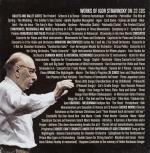Stravinsky, Works of Igor Stravinsky on 22 CD's. Volume 1 - Volume 6: Ballets /
Works of Igor Stravinsky on 22 CD’s. Volume 1 – Volume 6: Ballets / Volume 7: Ballets (Suites) / Volume 8: Symphony in E-Flat with Rehearsals and Talks / Volume 9: Symphonies / Volume 10: Concertos / Volume 11: Miniature Masterpieces / Volume 12 & 13: Chamber Music & Historical Recordings Part I & Part II / Volume 14: Operas / Volume 15: 35 Songs / Volume 16 & 17: The Rake’s Progress (1 & 2) / Volume 18 & 19: Oratorio – Melodrama (1 & 2) / Volume 20 & 21: Sacred Works (1 & 2) / Volume 22: Robert Craft conducts under the Supervision of Igor Stravinsky //
Holland, Sony Classical Music, 2007. CD Size. Booklet and 22 CD’s. Original Hardcover Cardboard-Box. Besides some minor bumping to the box, this rare set of 22 CD’s is in excellent condition. [Sony Classical].
Stravinsky dirigiert Stravinsky – auf 22 CDs dokumentiert diese Edition zum Sonderpreis, ein in der Musikgeschichte einmaliges Ereignis: eine umfassende authentische Interpretation der eigenen Werke durch einen Komponisten selbst.
So kann diese Edition ein Schlüssel zum Verstehen von Igor Strawinskys musikalischem Schaffen werden. Die frühesten Aufnahmen stammen aus den dreißiger Jahren, die letzten Einspielungen wurden, da Stravinsky selbst nicht mehr dazu in der Lage war, unter seiner Aufsicht von Robert Craft dirigiert, der Jahrzehnte mit ihm musikalisch zusammengearbeitet hatte. Um das Komponisten-Porträt auch im Bereich Klaviermusik und Kammermusik abzurunden, wurde die Edition zusätzlich mit Einspielungen anderer renommierter Künstler ergänzt.
Die 22CD-Box enthält ein Booklet mit einem dreisprachigen Einführungstext und sämtlichen Produktionsangaben.
Igor Fyodorovich Stravinsky (17 June [O.S. 5 June] 1882 – 6 April 1971) was a Russian composer, pianist and conductor, later of French (from 1934) and American (from 1945) citizenship. He is widely considered one of the most important and influential composers of the 20th century.
Stravinsky’s compositional career was notable for its stylistic diversity. He first achieved international fame with three ballets commissioned by the impresario Sergei Diaghilev and first performed in Paris by Diaghilev’s Ballets Russes: The Firebird (1910), Petrushka (1911), and The Rite of Spring (1913). The last transformed the way in which subsequent composers thought about rhythmic structure and was largely responsible for Stravinsky’s enduring reputation as a revolutionary who pushed the boundaries of musical design. His “Russian phase”, which continued with works such as Renard, L’Histoire du soldat, and Les noces, was followed in the 1920s by a period in which he turned to neoclassicism. The works from this period tended to make use of traditional musical forms (concerto grosso, fugue, and symphony) and drew from earlier styles, especially those of the 18th century. In the 1950s, Stravinsky adopted serial procedures. His compositions of this period shared traits with examples of his earlier output: rhythmic energy, the construction of extended melodic ideas out of a few two- or three-note cells, and clarity of form and instrumentation. (Wikipedia)
- Keywords: 20th century Classical Music · Audio CD (Classical Music) · Audio-CD · Classical Music · Classical Music CD · George Hitching – Classics CD-Collection · George Hitching – Music Collection · Music – Rare · Russian Composer · Stravinsky, Igor
- Language: English
- ISBN: 886971031126
- Inventory Number: 29874AB
EUR 220,--
© 2025 Inanna Rare Books Ltd. | Powered by HESCOM-Software














